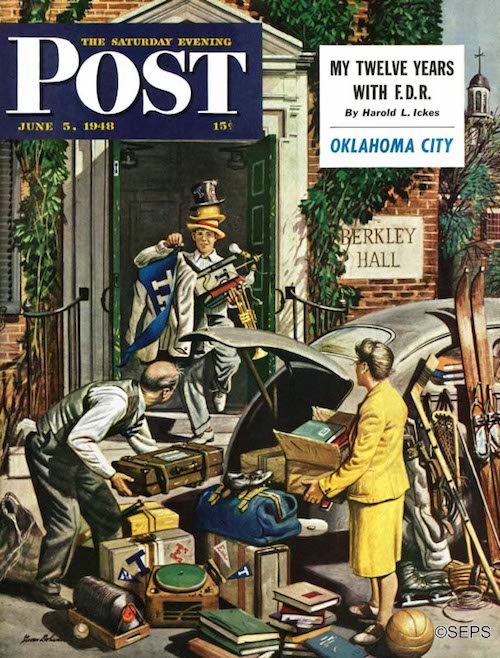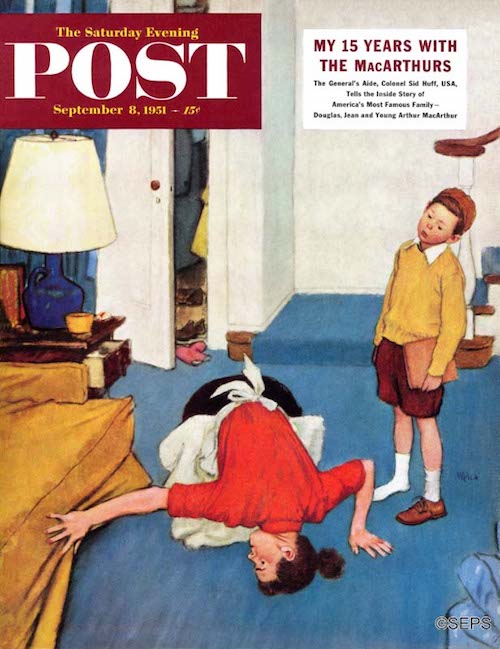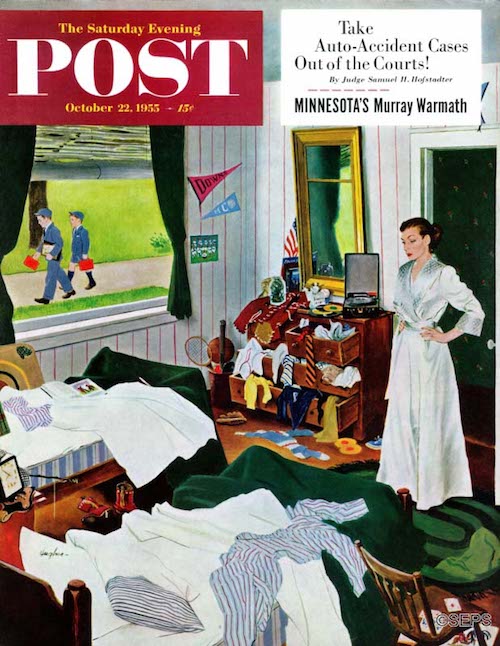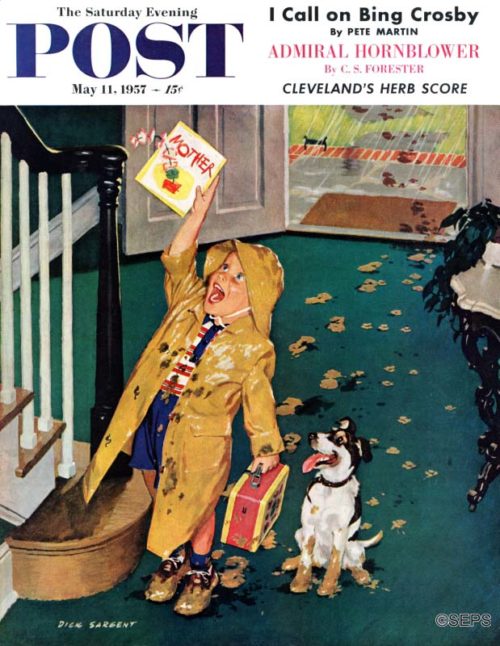Cover Gallery: Mid-Century Mothers and Sons
People talk about the special bond between mothers and sons, but some of these ‘40s and ‘50s moms don’t look so sure.

Frances Tipton Hunter
September 16, 1939
Any mother can relate to the problem of the growth spurt, as painted by Frances Tipton Hunter, who created 18 covers for The Saturday Evening Post. Hunter was particularly interested in drawing children and animals. She also illustrated a series of paper dolls in the 1920s for the Ladies’ Home Journal, which proved to be extremely popular.

George Hughes
April 17, 1948
[From the editors of the April 17, 1948, issue of the Post] The old, old losing fight to keep a boy in clean clothes, when in five minutes he can get dirtier than a grease monkey, is noted here by an artist taking his first crack at a cover. He is George Hughes, one of the country’s best-known illustrators, whose work in that field is highly familiar to Post readers.

Stevan Dohanos
June 5, 1948
[From the editors of the June 5, 1948, issue of the Post] Stevan Dohanos’ two sons, Peter and Paul, were in an Eastern boys’ school and about this time last year, getting-out time, he took the family car up to help them move home. A passenger car, he learned, is no proper vehicle for such a job. It calls for a light truck or van. Brooding about this, and what it meant for the future, Dohanos mentioned his trip to a friend with a son or sons in college. They told him his real moving jobs are still ahead, when he tries to load the contents of one college room. The artist made his sketches on the Yale campus, but rearranged things to suit his purposes. The boy is George Ritter, of Westport, Connecticut, no Yale man. The artist didn’t use a Yale man, on the remarkable theory that none would like to cut class.

George Hughes
October 16, 1948
[From the editors of the October 16, 1948, issue of the Post] It’s that suspenseful occasion when a young man puts on his first tuxedo to go out to a formal party—or more commonly, first puts on his father’s tuxedo or one borrowed from an older brother. Looking around for models, it occurred to artist George Hughes that some of his neighbors would serve excellently. The boy getting ready to dazzle them at the dinner dance, if he doesn’t forget and wear moccasins, is Tommy Rockwell, son of artist Norman Rockwell. The woman essaying the puzzling job of tying somebody else’s tie is Tommy’s mother. That is Tommy’s room, in Arlington, Vermont, and Hughes was much impressed—he thought it remarkably tidy, as boys’ rooms go. Temporarily tidy, at least, and you can’t ask more than that.

George Hughes
February 25, 1950
[From the editors of the February 25, 1950, issue of the Post] “Outfitters to Young Gentlemen,” proclaims the suit box, in a blundering effort to make the victim of its contents feel as swell as he looks. The young character does not wish to look like a young gentleman. What, he wonders in horror, will the gang down the street think when he bursts upon their gaze and is recognized as the guy they had always thought of as a normal, gun-toting cowboy? Will they clasp their hands as mother is doing, only with a less complimentary ecstasy? One ray of hope plays on the dark scene. In the next few weeks other misguided mothers will get this same new-suit fever, and on Easter Sunday many young cowpokes, in similar outrageous disguises, will be comforted by their companionship in misery.

Jack Welch
September 8, 1951
[From the editors of the September 8, 1951, issue of the Post] This mother’s face is charming upside-down, but if you will also stand on your head, you will find that she wears a choleric expression. She is mad at her son, which is unreasonable, for she herself has lost his shoe. He took it off last June, and is it not a woman’s duty to take care of her men’s clothing? We know where the shoe is: it is either in the Apache hide-out under the forsythia bush, in the cowpoke’s corral in the vacant lot down the street, or Fido is preserving it in his kennel as an objet d’art. Junior will go to school in sneakers, and nobody will care except his mother, who doesn’t go to school. Next week she very likely will think all this is funny, and what the moral of Jack Welch’s theme is, we don’t know.

Richard Sargent
September 20, 1952
[From the editors of the September 20, 1952, issue of the Post] Inventors are so smart at dreaming up new types of cloth, why doesn’t some bright fellow concoct a rubber-base fabric, so that the suit of an expanding boy can occasionally be put on a stretcher and thus increase in pace with its master? When this idea goes into production, we get a 10 per cent cut or somebody gets sued. Meanwhile, Dick Sargent’s distraught homemaker can take a few gussets in that stationary suit and hang it on Son #2, but then the boy will promptly outgrow it. Oh, for the deflated old days when it wasn’t necessary to stop eating for a while to finance a new suit or stop buying suits to eat. Well, better times ahead, mother! Soon the lads will be big enough to hand down their clothes to their father.

Amos Sewell
November 8, 1952
[From the editors of the November 8, 1952, issue of the Post] Little Johnny Tomorrow has just walked past young Mr. Today, making the latter look aged and out of date. It reminds us of a sad occasion when an airliner captain asked a little passenger if this was his first time up. “Fourteenth,” said the lad. ‘Can’t ever get up higher ‘n five, ten thousand feet in these old planes, though. How’s the United States ever going to build a space platform if you fellas can’t make altitude?” The captain, epitome of modernism, turned green and crept away to rev up his creaky old engines; and the boy should have been spanked for insolence, except that actually he had his feet on the ground. When artist Sewell’s youngster gets tired of wearing that helmet, the hostess could put it on somebody who is snoring.

Richard Sargent
December 20, 1952
[From the editors of the December 20, 1952, issue of the Post] What is lovelier than the glow of care-free joy in the faces of happy children? Will the lady on the cover have the time to defend her food and change those expressions to the pinched melancholy of starvation? She will if she can make it across the room in time. It will be fairly cruel if she imprisons the lads in the kitchen with nice, healthy, disillusioning peanut-butter sandwiches, but not as cruel as the time Dick Sargent set up that enchanting pastry in his dining room to paint. He has sons. The mouths of the sons began to water. They watered for a week. Two weeks. Three. Then the sons were released at the pastry. They ate it so fast they apparently did not notice it was petrified, claims the fiendish father.

George Hughes
October 22, 1955
[From the editors of the October 22, 1955, issue of the Post] Mother is making rapid progress at teaching the boys to maintain a tidy room; if George Hughes had painted this the day school opened, the detail would have given him a lame arm. Now, here is portrayed an intelligent female who in her delicate way molds the character of men; so, when her boys are seniors in college, they will be 27 per cent tidier than now. Then they will get married and never leave so much as a pipe cleaner lying about—for six weeks. After that they will revert to human beings, and what they don’t chuck around will be what they haven’t got. A woman’s picking-up-stuff is never done. Why doesn’t this mother shock the boys into tidy conduct by simply leaving their shambles untouched? Because they like it this way. She’d better go buy herself a new hat.

Richard Sargent
May 11, 1957
[From the editors of the May 11, 1957, issue of the Post] Johnny’s happy shout of “Mother, I’ve brought something for you!” is an understatement. Dick Sargent certainly can paint the most delicious-looking mud; did he use maple fudge for a model? Now then, when mother regards her ex-clean carpet and the adoration in the eyes of her seldom-so-soiled son, what type of emotion will possess her? Although a mother’s ups and downs often come simultaneously, and situations like this are all in the day’s work and love, the temperature of her reaction will depend partly on whether she’s a phlegmatic soul or pop-offy soul. Yet it’s a good bet that before she undertakes to make things come clean, she will administer to her son, fudge and all, a good, sound—kissing. Afterthought: if Fido decides to shake himself, all bets are off.

Amos Sewell
February 15, 1958
[From the editors of the February 15, 1958, issue of the Post] It’s typical of the male sex that Johnny is realizing how much his favorite lady means to him only when she is about to go away—and that’s enough psychology for this week. So John wants to cling to her, which will overlay a stunning new chocolate pattern on her dress, a chic addition to what seems to be a golden-fingerprint motif already put there by designer Amos Sewell. Without meaning to be unreasonable about this, is Miss Sitter going to come to the rescue or wait until the television program ends? Johnny’s situation is a bit pathetic as mamma delivers what football fans will recognize as a beautiful straight-arm; yet he does have loving parents, a swell home, luscious food, brisk entertainment and a pretty girl to dine with—what more can a young fellow ask?

Amos Sewell
November 29, 1958
[From the editors of the November 29, 1958, issue of the Post] It looks as if artist Amos Sewell’s cover urchin is entering a bathtub of his own free will, and is therefore outwitting himself. Johnny’s decision to try out his diving gear has made him forget to remember that using water for the purpose of getting clean is bitterly repugnant to him. Mother could remind him of this, but why burden his little mind with confusing thoughts? So down Johnny will dive into the mysterious depths, seeking treasure on the floor of the sea, and down there he may well find a bar of soap. Then if mother and son excitedly agree that Johnny has found a rare specimen of submarine life worth maybe a trillion dollars or more, they will be sharing just a little white lie from which, as mother makes with the soap, great good will come.